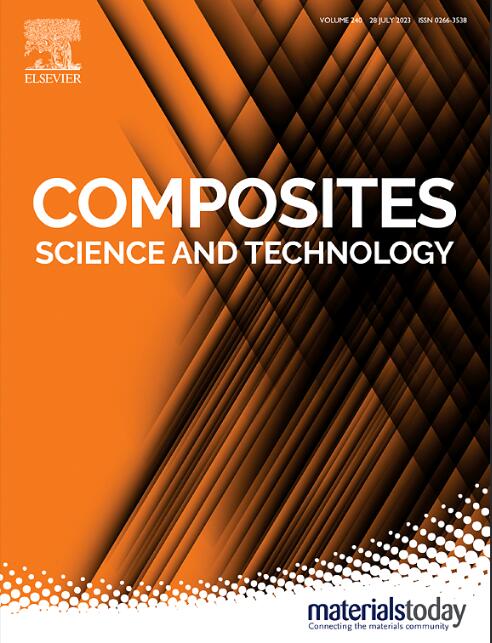通过多酚介导的磷酸锆纳米片组装实现多功能生物基水性聚氨酯
IF 9.8
1区 材料科学
Q1 MATERIALS SCIENCE, COMPOSITES
引用次数: 0
摘要
可持续生物基水性聚氨酯(WPU)以其良好的环境安全性和优异的性能在工业上得到了广泛的应用。然而,在生物基WPU中实现优异的机械性能和良好的多功能仍然是一个相当大的挑战。在这项工作中,我们提出了一种简单有效的界面工程策略,通过磷酸辅助剥离和多酚介导的磷酸锆纳米片(ZrP NPs)的协同作用,制备多功能蓖麻油基超分子WPU复合材料,用于图案化皮革涂层。可调的ZrP基超分子组件,TA与pZrP NPs的质量比为2.0 wt.%, pH >;制作了5.0个以操纵WPU分子的组装。结合在ZrP NPs界面上的活性TA分子可以通过TA分子的酚基与WPU分子的官能团之间形成氢键相互作用而起到有机连接的作用。得益于这种氢键驱动的共组装,所得的超分子WPU复合膜不仅具有优异的透明度和增强的机械强度、热稳定性和阻燃性能,而且具有适合于图图化皮革涂层的光致发光性能。峰值放热速率(PHRR)由389.45 kW/m2降至199.75 kW/m2,总放热速率(THR)由15.49 MJ/m2降至13.58 MJ/m2。我们设想,本研究有助于可持续多功能生物基WPU涂料的发展,在信息加密和显示等方面具有重要的应用潜力。本文章由计算机程序翻译,如有差异,请以英文原文为准。

Enabling multifunctional bio-based waterborne polyurethane through polyphenol-mediated assembly of zirconium phosphate nanoplatelets for patternable coating
Sustainable bio-based waterborne polyurethane (WPU) has been widely used in a wide range of industrial applications owing to its favorable environmental safety and excellent properties. However, achieving superior mechanical properties and favorable multifunctionalities in bio-based WPU remains a considerable challenge. In this work, we proposed a facile and effective interfacial engineering strategy which was synergistically enabled via phosphoric acid-assisted exfoliation and polyphenol-mediated assembly of zirconium phosphate nanoplatelets (ZrP NPs) to prepare multifunctional castor oil-based supramolecular WPU composites for patternable leather coating. Tunable ZrP based supramolecular assemblies with the weight ratio of TA to pZrP NPs of 2.0 wt.% and pH > 5.0 were fabricated to manipulate the assembly of the WPU molecules. Active TA molecules bound on the interfaces of ZrP NPs can function as organic junctions through the formation of hydrogen-bonding interactions between the phenolic groups of TA molecules and the functional groups of WPU molecules. Benefiting from this hydrogen-bonding-driven co-assembly, the resultant supramolecular WPU composite films not only exhibited excellent transparency and reinforced mechanical strengths, thermal stability, and flame-retardant properties, but also possessed photoluminescent properties suitable for patternable leather coating. For example, the peak heat release rate (PHRR) was decreased from 389.45 kW/m2 to 199.75 kW/m2, and the total heat release (THR) was from 15.49 MJ/m2 to 13.58 MJ/m2. We envision that this study contributes to the development of sustainable multifunctional bio-based WPU coatings with significant potential for advanced applications in information encryption and displays, etc.
求助全文
通过发布文献求助,成功后即可免费获取论文全文。
去求助
来源期刊

Composites Science and Technology
工程技术-材料科学:复合
CiteScore
16.20
自引率
9.90%
发文量
611
审稿时长
33 days
期刊介绍:
Composites Science and Technology publishes refereed original articles on the fundamental and applied science of engineering composites. The focus of this journal is on polymeric matrix composites with reinforcements/fillers ranging from nano- to macro-scale. CSTE encourages manuscripts reporting unique, innovative contributions to the physics, chemistry, materials science and applied mechanics aspects of advanced composites.
Besides traditional fiber reinforced composites, novel composites with significant potential for engineering applications are encouraged.
 求助内容:
求助内容: 应助结果提醒方式:
应助结果提醒方式:


